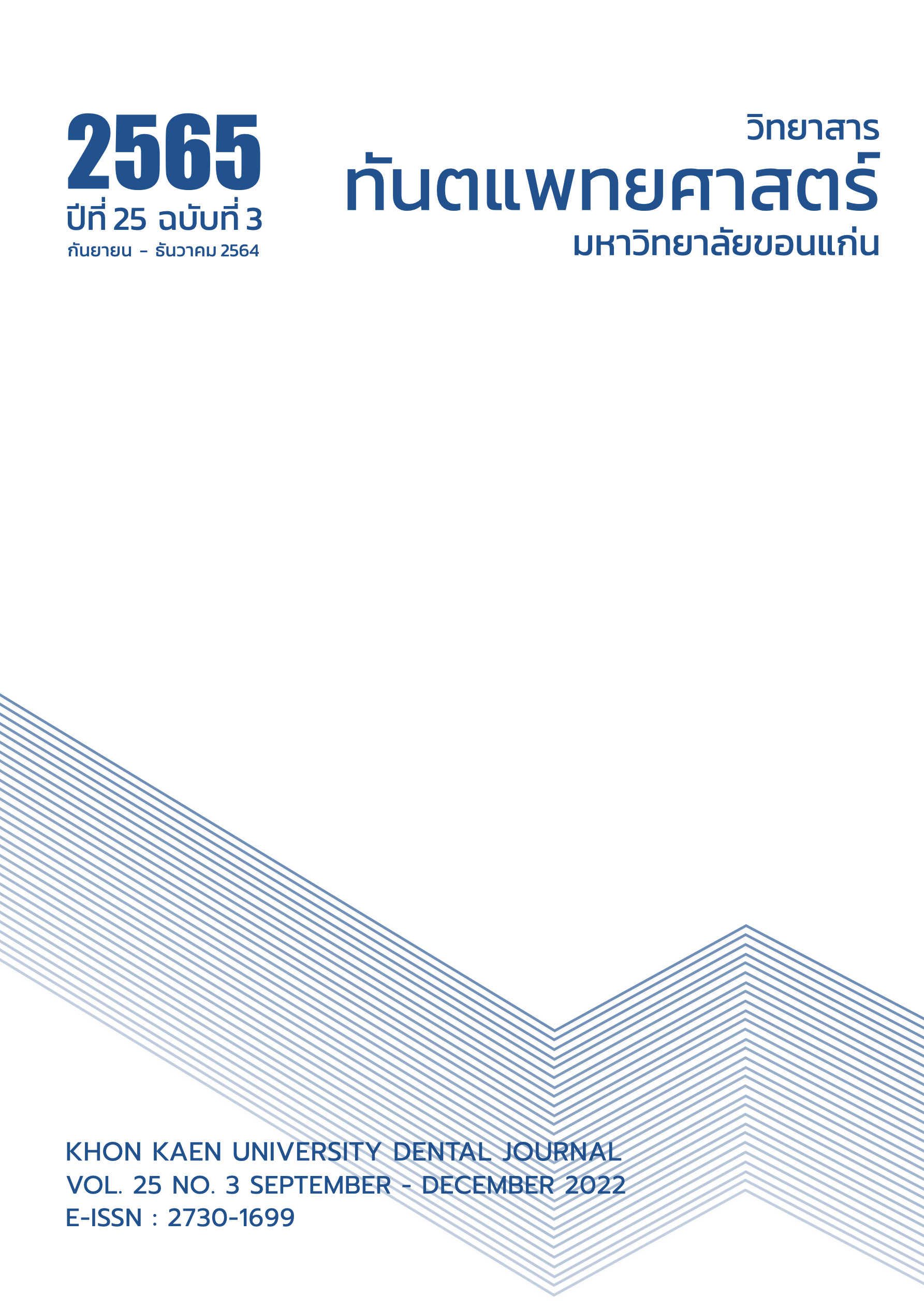ผลของอัตราส่วนผงต่อน้ำโดยรวมต่อค่าความแข็งผิว และสมบัติวิสโคอิลาสติกช่วงแรกของวัสดุเสริมฐานฟันเทียมชั่วคราวชนิดอ่อนที่ผสมน้ำมันตะไคร้ภูเขา
Main Article Content
บทคัดย่อ
การศึกษานี้มีวัตถุประสงค์เพื่อศึกษาความแข็งผิวและสมบัติวิสโคอิลาสติกช่วงแรกของวัสดุเสริมฐานฟันเทียมชนิดอ่อนที่ผสมด้วยน้ำมันตะไคร้ภูเขา โดยประกอบด้วย 9 กลุ่มการทดลอง ที่ส่วนผสมมีความแตกต่างในอัตราส่วนของผงต่อน้ำ (0.9, 1.2, และ 1.5) และความเข้มข้นของน้ำมันตะไคร้ภูเขา (ร้อยละ 0, 10, และ 20 โดยน้ำหนัก) ทั้งนี้วัสดุแต่ละกลุ่มถูกเตรียมเพื่อนำมาวัดความแข็งผิวที่ 2 ชั่วโมง และ 7 วันด้วยเครื่องวัดความแข็งแบบชอร์และมีการทดสอบสมบัติวิสโคอิลาสติกช่วงแรกของวัสดุ ด้วยเครื่องวิเคราะห์การไหลแบบจานแกว่งตั้งแต่เริ่มผสมวัสดุจนครบ 30 นาที ซึ่งประกอบไปด้วยการหาระยะเวลาการก่อวุ้น ค่ามอดูลัสสะสมและมอดูลัสสูญเสีย โดยแต่ละการทดลองมีการทำซ้ำ 5 ครั้ง จากผลการศึกษาพบว่าอัตราส่วนของผงต่อน้ำของวัสดุเสริมฐานฟันเทียมชนิดอ่อนเป็นปัจจัยหลักต่อค่าความแข็งผิวของวัสดุ โดยกลุ่มที่ใช้อัตราส่วนของผงต่อน้ำมากจะมีค่าความแข็งผิวที่เวลา 2 ชั่วโมง และ 7 วันสูงกว่าอย่างมีนัยสำคัญ (p<0.05) ทั้งนี้การใส่น้ำมันตะไคร้ภูเขาร้อยละ10 ลงในวัสดุเสริมฐานฟันเทียมชนิดอ่อนไม่ส่งผลต่อความแข็งผิวของวัสดุ อย่างไรก็ตามการผสมน้ำมันตะไคร้ภูเขาที่ความเข้มข้นร้อยละ 20 ทำให้ความแข็งผิวที่ 2 ชั่วโมงของวัสดุ ต่ำกว่ากลุ่มอื่นอย่างมีนัยสำคัญ (p<0.05) นอกจากนั้นพบว่าอัตราส่วนของผงต่อน้ำยังเป็นปัจจัยหลักที่ส่งผลต่อสมบัติวิสโคอิลาสติกช่วงแรกของวัสดุเสริมฐานฟันเทียมชนิดอ่อน โดยกลุ่มที่ใช้อัตราส่วนของผงต่อน้ำมากกว่าจะมีระยะเวลาการก่อวุ้นสั้นลง และค่ามอดูลัสสะสมและสูญเสียสูงขึ้นอย่างมีนัยสำคัญ (p<0.05) ทั้งนี้ไม่พบว่าความเข้มข้นของน้ำมันตะไคร้ภูเขาส่งผลต่อสมบัติวิสโคอิลาสติกช่วงแรกของวัสดุ โดยสรุปจากการศึกษานี้ พบว่าความแข็งผิวและสมบัติวิสโคอิลาสติกช่วงแรกของวัสดุเสริมฐานฟันเทียมชนิดอ่อนที่ผสมน้ำมันตะไคร้ภูเขาขึ้นกับปัจจัยอัตราส่วนผงต่อน้ำเป็นหลัก โดยที่ความเข้มข้นของน้ำมันตะไคร้ภูเขาไม่ได้มีผลเด่นชัดต่อสมบัติดังกล่าวของวัสดุ
Article Details

This work is licensed under a Creative Commons Attribution-NonCommercial-NoDerivatives 4.0 International License.
บทความ ข้อมูล เนื้อหา รูปภาพ ฯลฯ ทีได้รับการลงตีพิมพ์ในวิทยาสารทันตแพทยศาสตร์ มหาวิทยาลัยขอนแก่นถือเป็นลิขสิทธิ์เฉพาะของคณะทันตแพทยศาสตร์ มหาวิทยาลัยขอนแก่น หากบุคคลหรือหน่วยงานใดต้องการนำทั้งหมดหรือส่วนหนึ่งส่วนใดไปเผยแพร่ต่อหรือเพื่อกระทำการใด ๆ จะต้องได้รับอนุญาตเป็นลายลักษณ์อักษร จากคณะทันตแพทยศาสตร์ มหาวิทยาลัยขอนแก่นก่อนเท่านั้น
References
Garcia LT, Jones JD. Soft liners. Dent Clin North Am 2004;48(3):709-20.
Prasad A, Prasad BR, Shetty V, Shastry CS. Tissue conditioners: a review. NUJHS 2014;4(2):152-7.
Mack PJ. Denture soft lining materials: clinical indications. Aust Dent J 1989;34(5):454-8.
Bulad K, Taylor RL, Verran J, McCord JF. Colonization and penetration of denture soft lining materials by Candida albicans. Dent Mater 2004;20(2):167-75.
Kang SH, Lee HJ, Hong SH, Kim KH, Kwon TY. Influence of surface characteristics on the adhesion of Candida albicans to various denture lining materials. Acta Odontol Scand 2013;71(1): 241-8.
Iqbal Z, Zafar MS. Role of antifungal medicaments added to tissue conditioners: A systematic review. J Prosthodont Res 2016;60(4):231-9.
Chopde N, Pharande A, Khade MN, Khadtare YR, Shah SS, Apratim A. In vitro antifungal activity of two tissue conditioners combined with nystatin, miconazole and fluconazole against Candida albicans. J Contemp Dent Pract 2012;13(5):695-8.
Douglas WH, Walker DM. Nystatin in denture liners--an alternative treatment of denture stomatitis. Br Dent J 1973;135(2):55-9.
Falah-Tafti A, Jafari AA, Lotfi-Kamran MH, Fallahzadeh H, Hayan RS. A comparison of the efficacy of nystatin and fluconazole incorporated into tissue conditioner on the in vitro attachment and colonization of Candida albicans. Dent Res J (Isfahan) 2010;7(1):18-22.
Kanathila H, Bhat AM, Krishna PD. The effectiveness of magnesium oxide combined with tissue conditioners in inhibiting the growth of Candida albicans: an in vitro study. Indian J Dent Res 2011;22(4):613.
Nam KY. In vitro antimicrobial effect of the tissue conditioner containing silver nanoparticles. J Adv Prosthodont 2011;3(1):20-4.
Amornvit P, Choonharuangdej S, Srithavaj T. Lemongrass-incorporated tissue conditioner against Candida albicans culture. J Clin Diagn Res 2014;8(7):ZC50-2.
Catalan A, Pacheco JG, Martinez A, Mondaca MA. In vitro and in vivo activity of Melaleuca alternifolia mixed with tissue conditioner on Candida albicans. Oral Surg Oral Med Oral Pathol Oral Radiol Endod 2008;105(3):327-32.
Srivatstava A, Ginjupalli K, Perampalli NU, Bhat N, Ballal M. Evaluation of the properties of a tissue conditioner containing origanum oil as an antifungal additive. J Prosthet Dent 2013;110(4): 313-9.
Kumpanich J, Eiampongpaiboon T, Kanchanavasita W, Chitmongkolsuk S, Puripattanavong J. Effect of Piper betle extract on anti-candidal activity, gelation time, and surface hardness of a short-term soft lining material. Dent Mater J 2020;39(6):1016-21.
Pattanachaipuvanon P, Ratanajanchai M. Viscoelasticity at initial setting and gelation time of a short-term soft liner incorporated with clove, star anise, and kaffir lime essential oils. M Dent J 2021;41(2):122-31.
Feng T, Xu Y, Cai XH, Du ZZ, Luo XD. Antimicrobially active isoquinoline alkaloids from Litsea cubeba. Planta Med 2009;75(1):76-9.
Leite MC, Bezerra AP, de Sousa JP, Guerra FQ, Lima Ede O. Evaluation of antifungal activity and mechanism of action of citral against Candida albicans. Evid Based Complement Alternat Med 2014;2014:378280.
Lima IO, Nobrega FM, Oliveira WA, Lima EO, Menezes EA, Cunha FA, et al. Anti-Candida albicans effectiveness of citral and investigation of mode of action. Pharm Biol 2012;50(12):1536-41.
Wang H, Liu Y. Chemical composition and antibacterial activity of essential oils from different parts of Litsea cubeba. Chem Biodivers 2010;7(1):229-35.
Jones DW, Hall GC, Sutow EJ, Langman MF, Robertson KN. Chemical and molecular weight analyses of prosthodontic soft polymers. J Dent Res 1991;70(5):874-9.
Murata H, McCabe JF, Jepson NJ, Hamada T. The influence of immersion solutions on the viscoelasticity of temporary soft lining materials. Dent Mater 1996;12(1):19-24.
ISO 10139-1:2018 Dentistry soft lining materials for removable dentures. Part 1: Materials for short-term use. Switzerland. 2018;3:10.
Murata H, Chimori H, Hamada T, McCabe JF. Viscoelasticity of dental tissue conditioners during the sol-gel transition. J Dent Res 2005;84(4):376-81.
Murata H, Hamada T, Djulaeha E, Nikawa H. Rheology of tissue conditioners. J Prosthet Dent 1998;79(2):188-99.
Immergut EH, Mark HF. Principles of plasticization. In: Gould RF, Ed. Plasticization and Plasticizer Processes; Advances in Chemistry vol 48. Washington DC: American Chemical Society; 1965. p.1–26.
Vaughan CD. Using solubility parameters in cosmetics formulation. J Soc Cosmet Chem 1985; 36(5):319-33.
Hansen CM. Hansen solubility parameters: a user's handbook. 2nd ed. Boca Raton, FL: CRC press; 2007.
Parker S, Braden M. Formulation of tissue conditioners. Biomaterials 1990;11(8):579-84.
Braden M. Tissue conditioners. I. Composition and structure. J Dent Res 1970;49(1):145-8.
Winter HH, Chambon F. Analysis of linear viscoelasticity of a crosslinking polymer at the gel point. J Rheol 1986;30(2):367-82.
Braden M. Tissue conditioners: II. Rheologic properties. J Dent Res 1970;49(3):496-501.
Murata H, Iwanaga H, Shigeto N, Hamada T. Initial flow of tissue conditioners-influence of composition and structure on gelation. J Oral Rehabil 1993;20(2):177-87.

